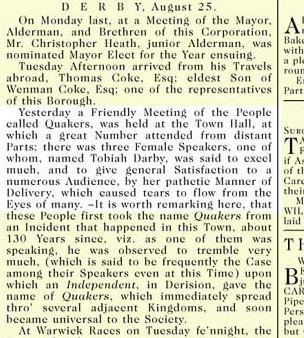Full Name Abiah Maude Nationality British | Known for Evangelism Name Abiah Darby | |
 | ||
Died 1793, Coalbrookdale, United Kingdom | ||
Abiah Darby (born Abiah Maude; 1716–1794) was an English minister in the Quaker church based in Coalbrookdale. She was also the wife of the iron industrialist Abraham Darby. Abiah kept a journal and she sent letters which recorded the Darby family's achievements. One of her letters has been used to identify the start of the Industrial Revolution.
Contents
Life
Abiah Maude was born in 1716 into a Quaker family headed by Samuel and Rachel (born Warren) Maude. By her teens she was moved to preach, but she took no action. She wanted to marry John Sinclair, but her widowed mother resisted the match until February 1734. Within three years, Abiah Sinclair was a widow with a daughter named Rachel. She rejected her sister's requests to rejoin society. Instead, she carried out her religious duties until 1745, when she met the Quaker widower Abraham Darby of Coalbrookdale. They married at Preston Patrick on 9 March 1746.
Her new husband was revolutionising the iron industry and she became the hostess to businessmen as well as fellow Quakers. Abiah recorded the details of many of their visitors between 1752 and 1769 in her journals. They had seven children, of whom four survived infancy. Sarah, Mary, Samuel and another Abraham Darby. Whilst her children were still small, Abiah Darby gave in to her inner need to preach in 1746. Her daughter, Mary Darby, was still a baby and her husband was busy introducing his improvements to the smelting process of the ironworks in Coalbrookdale where he was a partner. Nevertheless, Abraham accompanied her on some of her preaching trips by horse; on other occasions, she was usually accompanied by Ann Summerfield. It has been said that Abiah Darby "broke the shackles" of her gender's role in her evangelism of the Quaker message. In 1750 Abraham and Abiah moved to their new house of Sunniside set in its own park. This house was named after Abiah's parent's home in Bishopswearmouth.
Despite her severe outlook, Darby did not attract the hostility that faced some of her fellow preachers. She was credited with improving communication between the male and female groups of Friends within the Quaker church in 1754. However, she did not just preach at home. In 1756 she wrote in her journal about the food riots, but she also spoke at three public meetings as well as at Chesterfield in Derbyshire, Ambleside in the Lake District, and Newcastle on Tyne and Shields in the north-east of England. She was also able to obtain permission to address the soldiers stationed in Berwick on England's north-east coast bordering Scotland.
In 1763 her husband died. In the same year she published Useful Instruction for Children by Way of Question and Answer, which she had written for her children. Abiah was active in supporting the creation of Sunday Schools, and she visited Shrewsbury Gaol primarily to see fellow Quakers who had been jailed for non-payment of church tithes. Also in 1763, she wrote a letter which is still extant but it is not recorded whom it was sent to. This letter describes the Darby family's achievements and she records when her husband's father first smelted iron using coke instead of charcoal. This date has been used to identify the start of the Industrial Revolution as 1709.
In August 1774 Darby spoke at a regional meeting of Quakers at Derby Town Hall. The Derby Mercury reported her name as Tobiah and said she was the best of three female speakers. The journalist also noted that she was speaking in Derby and this was the town where the Quakers first got their name. This was the town, but the newspaper gave the wrong reason. It was a Derby magistrate Gervase Bennet who first used the term to deride George Fox in 1650 as he tried him for blasphemy. It is thought that Darby was speaking at the same place at which George Fox had been imprisoned, although she may not have been aware of it, as this was a new town hall.
After twenty years of widowhood, she was increasingly confined to her home by infirmity. "Mother Darby" died at her home "Sunniside" in Colebrookdale on 26 June 1794. Sunniside was demolished in the nineteenth century, but her first home, Dale House, is preserved as part of a museum.
